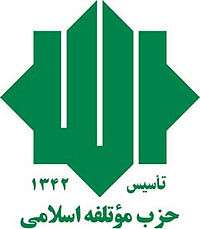Islamic Coalition Party
Islamic Coalition Party | |
|---|---|
 | |
| Secretary-General | Mohammad-Nabi Habibi |
| Spiritual leader | Ruhollah Khomeini (deceased)[1] |
| Deputy Secretary-General | Asadollah Badamchian |
| Head of Central Council | Mostafa Mir-Salim |
| Founded | August 2, 1963 |
| Legalised | December 11, 1990[2] |
| Headquarters | Tehran, Iran |
| Newspaper |
Shoma[1] Resalat (1986–1997)[1] |
| Guild wing | Union of Islamic Associations of Guilds and Bazaaris[3] |
| Ideology | |
| Political position | Right-wing[6] |
| Religion | Shia Islam |
| National affiliation |
|
| Colors | Islamic green |
| Website | |
|
motalefeh | |
The Islamic Coalition Party[lower-alpha 1] (ICP; Persian: حزب مؤتلفه اسلامی, translit. Ḥezb-e moʾtalefa-ye eslāmi) is a conservative political party in Iran that favors economic liberalism.
The party is the pivotal organization within Front of Followers of the Line of the Imam and the Leader and is considered a lay ally of the influential Combatant Clergy Association.[8] Tough still very active and influential, the organization experienced a gradual elimination from political power after rise of new conservative rivals in 2000s.[9][1]
One of the oldest among the active parties in Iran,[6] it represents older generations of conservatives[7] and its main base of support is among bazaari merchants and shopkeepers in Grand Bazaar of Tehran and other cities, petite bourgeoisie and traditionalist clerics.[4][5][9] It is probably the only political organization in Iran which possesses an organic relation with such a social base.[1]
Since 1979, the party members have held high government offices[3] and are influential players in the economy of Iran, dominating Iran Chamber of Commerce Industries and Mines (ICCIM)[10][1] and having "a say in the appointment of the minister of commerce".[4] The party has also interactions with Mostazafan Foundation, Imam Khomeini Relief Foundation and Mashhad-based Astan Quds Razavi.[10]
The party has affiliated parochial schools for boys and girls.[7]
History
It played a vital role in the success of the Iranian Revolution.[1] Following the revolution, it reduced its activities many members joined the Islamic Republic Party as leading members, resuming its activities after the latter's dissolution in 1987.[9][1]
Secretary-generals
| Name | Tenure | Ref |
|---|---|---|
| Habibollah Asgaroladi | 1987–2004 | [1] |
| Mohammad-Nabi Habibi | 2004–present | [1] |
Notes
References
- 1 2 3 4 5 6 7 8 9 10 11 Rahnema, Ali (February 20, 2013) [December 15, 2008]. "ii. Jamʿiyat-e Moʾtalefa and the Islamic Revolution". JAMʿIYAT-E MOʾTALEFA-YE ESLĀMI i. Hayʾathā-ye Moʾtalefa-ye Eslāmi 1963-79. Encyclopædia Iranica. Fasc. 5. XIV. New York City: Bibliotheca Persica Press. pp. 483–500. Retrieved March 15, 2016.
- ↑ "List of Legally Registered Parties in Iran". Khorasan Newspaper. Pars Times. July 30, 2000. p. 4. Retrieved 21 August 2015.
- 1 2 3 Robin B. Wright, ed. (2010), The Iran Primer: Power, Politics, and U.S. Policy, US Institute of Peace Press, p. 110, ISBN 1601270844
- 1 2 3 4 5 Bashiriyeh, Hossein (Spring–Summer 2001). "Civil Society and Democratisation during Khatami's First Term". Global Dialogue. Centre for World Dialogue. 3 (2–3): 19–26. ISSN 1986-2601.
- 1 2 3 4 Buchta, Wilfried (2000), Who rules Iran?: the structure of power in the Islamic Republic, Washington DC: The Washington Institute for Near East Policy, The Konrad Adenauer Stiftung, p. 14–16, ISBN 0-944029-39-6
- 1 2 Asayesh, Hossein; Halim, Adlina Ab.; Jawan, Jayum A.; Shojaei, Seyedeh Nosrat (March 2011). "Political Party in Islamic Republic of Iran: A Review". Journal of Politics and Law. Canadian Center of Science and Education. 4 (1): 221–230. ISSN 1913-9047.
- 1 2 3 Barry M. Rubin, ed. (2010), "From Opposition to Mainstream—Motalefeh-yi Islami", Guide to Islamist Movements, 2, M.E. Sharpe, pp. 254–256, ISBN 0765641380
- ↑ Matsunaga, Yasuyuki (2008). "Political Parties". Iran Today: An Encyclopedia of Life in the Islamic Republic. 2. Greenwood Press. p. 392. ISBN 031334163X.
- 1 2 3 Khani, Mohamamd Hassan (17 July 2012). "Political Parties in the Islamic Republic of Iran". Iran Review. Retrieved 1 April 2016.
- 1 2 Adelkhah, Fariba (2015). The Thousand and One Borders of Iran: Travel and Identity. Iranian Studies. 27. Routledge. p. 25, 165. ISBN 1317418972.